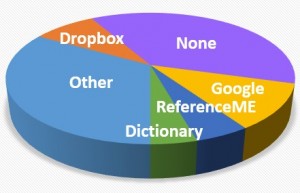
-
Are you appy with your mobile?
 Helping you get the most out of educational apps
Helping you get the most out of educational appsIn the summer we asked you (our students) about how you use your mobile phones and we received some great feedback. In relation to one particular question of use, you told us that on the whole you used apps, but aren’t sure which ones may help you with your study.
From this we felt it would be great to hear about how students are using apps whilst here at Edge Hill, with a future plan to share this knowledge so that it might help others.
So our first venture was at last Friday’s Get Connected roadshow in the University Library, where we asked you to make our Christmas tree appy. Which you did in your masses, aided no doubt by the offer of a free chocolate or pen. In total 117 students noted on a gift tag, both their favourite app and a study app that they would recommend to other students, and these suggestions decorated our tree. As you can see from our picture, you made our Christmas tree very appy indeed.
This is what you told us:
Favourite Mobile Apps
 No prizes for guessing what your favourite app was – Facebook with 25% of all decorations.
No prizes for guessing what your favourite app was – Facebook with 25% of all decorations.Twitter came in second with just over half the votes of Facebook at 13%.
Interestingly, there was a wide range of other favourite apps, with 39 different ones nominated, showing a real diversity to your usage of mobile apps.
Recommended Study Apps
 The most popular app that you would recommend to your fellow students was Google with 11% of all results.
The most popular app that you would recommend to your fellow students was Google with 11% of all results.Second was Dropbox with 9%, then ReferenceME at 5% and Dictionary taking fourth place with 4%.
31 different study apps were recommended, however 38% said that they hadn’t ever used an app for study.
Not surprisingly 100% of the chocolates were appy’ly consumed!
Following this successful start, we really want to continue hearing of your experiences with apps – especially the ones you use in your studies which you think might be a good recommendation to others. If you want to help, please email [email protected] with the title ‘Are you appy with your mobile?’, or add a comment to this blog post.
Catch further updates and information on study apps through this blog, or our social media.
Facebook EHULearnService
Twitter @EHULearnServiceWishing you a very appy Christmas
From the Learning Services Apps Review Team
-
Your Digital Tattoo: What the web says about you! – For Staff
 Is how you present yourselves online important? When people search for information about you what might they find, and how does that affect your reputation and employability? How can you take control of what people can find about you online?
Is how you present yourselves online important? When people search for information about you what might they find, and how does that affect your reputation and employability? How can you take control of what people can find about you online?Over the last few years we’ve spoken with hundreds of Edge Hill students about issues these questions bring up, and we’ve helped many to develop their online presence to make it look more professional. Now it’s your turn to look at your own online presence, your ‘digital tattoo’ as some call it, and to think about how you could talk about this important subject with your own students.
We’re running a session this Wednesday (4th December 2013) from 1:00-2:00pm, in the LINC IT Training Room (room S5 on the top floor).
Please book on the session via the Staff Learning and Development booking system.
Quotes from previous attendees:
- “I think this is a session that everyone can benefit from and provides useful information that we can pass on to students with regards to developing a positive online presence.”
- “I really enjoyed the opportunity to discuss the elements of this presentation / session and the potential impact for myself and the student experience. A thought provoking session”
Peter Beaumont
Learning Technology Development Officer
-
Expired Passwords Need Your Attention
We’ve established an excellent record of Learning Edge Blackboard 9.1 availability (achieving 99.95% uptime last year) and we take your need to access the system very seriously. So, on Monday, having noted a higher volume of calls to the helpdesk and tweets from some of you saying that you’d been having trouble accessing Blackboard we immediately began investigating. What we discovered was that many of you had expired passwords, but didn’t realise it.
To maintain the security of your personal information, student passwords should be changed every 90 days (30 days for staff), but, as more and more of you are using your own devices (laptops, tablets and mobile phones) to log into the Edge Hill systems, you don’t always see the reminder that your password is due to expire. The first you know about it is when you can’t login to the resources you need.
When your password expires you can’t:
- Connect your mobile devices or laptop to Eduroam WIFI
- Connect to the internet via the Captive Portal on hall PCs
- Login to the Go Portal on or off campus
- Login to learningedge.edgehill.ac.uk or the Blackboard Mobile Learn app
If you find you can’t access any Edge Hill systems, the first thing to try is resetting your password. You can do this via the GO Portal login page, providing you’ve added an alternative email address to your GO account. If you haven’t added an alternative email address, we recommend you do this now – edit ‘settings’ in GO. Of course, you’ll need an internet connection to access the GO portal, so if you’re in your halls, or using a mobile device or laptop on campus, you’ll need to use one of the open access PCs to do this.
It will also be a good idea to make a note in your diary every time you set a new password to remind you when you’ll need to change it again. This way, if you miss the on-campus reminder, you still won’t get locked out!
I hope this information has been helpful and I trust that you are now logged in. If you need any further information or assistance please contact the Learning Services help desk on 01695 584286 or visit www.ehu.ac.uk/askus.
Meg Juss, Learning Technology Development Manager



